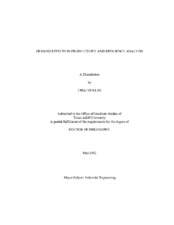| dc.contributor.advisor | Johnson, Andrew L. | |
| dc.creator | Lee, Chia-Yen | |
| dc.date.accessioned | 2012-07-16T15:57:56Z | |
| dc.date.accessioned | 2012-07-16T20:28:10Z | |
| dc.date.available | 2014-09-16T07:28:20Z | |
| dc.date.created | 2012-05 | |
| dc.date.issued | 2012-07-16 | |
| dc.date.submitted | May 2012 | |
| dc.identifier.uri | https://hdl.handle.net/1969.1/ETD-TAMU-2012-05-10863 | |
| dc.description.abstract | Demand fluctuations will bias the measurement of productivity and efficiency. This dissertation described three ways to characterize the effect of demand fluctuations.
First, a two-dimensional efficiency decomposition (2DED) of profitability is proposed for manufacturing, service, or hybrid production systems to account for the demand effect. The first dimension identifies four components of efficiency: capacity design, demand generation, operations, and demand consumption, using Network Data Envelopment Analysis (Network DEA). The second dimension decomposes the efficiency measures and integrates them into a profitability efficiency framework. Thus, each component's profitability change can be analyzed based on technical efficiency change, scale efficiency change and allocative efficiency change.
Second, this study proposes a proactive DEA model to account for demand fluctuations and proposes input or output adjustments to maximize effective production. Demand fluctuations lead to variations in the output levels affecting measures of technical efficiency. In the short-run, firms can adjust their variable resources to address the demand fluctuates and perform more efficiently. Proactive DEA is a short-run capacity planning method, proposed to provide decision support to a firm interested in improving the effectiveness of a production system under demand uncertainty using a stochastic programming DEA (SPDEA) approach. This method improves the decision making related to short-run capacity expansion and estimates the expected value of effectiveness given demand.
In the third part of the dissertation, a Nash-Cournot equilibrium is identified for an oligopolistic market. The standard assumption in the efficiency literature that firms desire to produce on the production frontier may not hold in an oligopolistic market where the production decisions of all firms will determine the market price, i.e. an increase in a firm's output level leads to a lower market clearing price and potentially-lower profits. Models for both the production possibility set and the inverse demand function are used to identify a Nash-Cournot equilibrium and improvement targets which may not be on the strongly efficient production frontier. This behavior is referred to as rational inefficiency because the firm reduces its productivity levels in order to increase profits. | en |
| dc.format.mimetype | application/pdf | |
| dc.language.iso | en_US | |
| dc.subject | Productivity and Efficiency Analysis | en |
| dc.subject | Data Envelopment Analysis | en |
| dc.subject | Stochastic Optimization | en |
| dc.subject | Nash Equilibrium | en |
| dc.subject | Demand Fluctuation | en |
| dc.title | Demand Effects in Productivity and Efficiency Analysis | en |
| dc.type | Thesis | en |
| thesis.degree.department | Industrial and Systems Engineering | en |
| thesis.degree.discipline | Industrial Engineering | en |
| thesis.degree.grantor | Texas A&M University | en |
| thesis.degree.name | Doctor of Philosophy | en |
| thesis.degree.level | Doctoral | en |
| dc.contributor.committeeMember | Wilhelm, Wilbert E. | |
| dc.contributor.committeeMember | Butenko, Sergiy | |
| dc.contributor.committeeMember | Puller, Steven L. | |
| dc.contributor.committeeMember | Sickles, Robin C. | |
| dc.type.genre | thesis | en |
| dc.type.material | text | en |
| local.embargo.terms | 2014-07-16 | |


